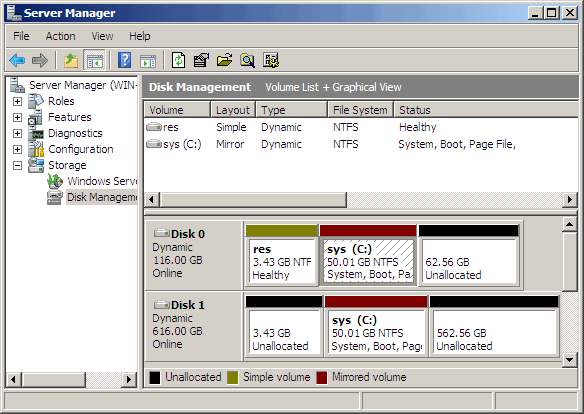

- #Unraid setup mirror raid how to
- #Unraid setup mirror raid software
- #Unraid setup mirror raid windows
Whats the best way to go about this, considering there are several VMs and dockers residing on the current cache drive Play it safe, shut down VMs and dockers, move to array, disable VM and docker services. Hi all, I have another SSD to add to the first, same brand & model, in mirror configuration. Select a location for a mirror of C:"Ĭhoose Disk 1 to make a mirror of Disk 0 on it: Add second cache drive to mirror the first.

"Adding a mirror to an existing volume provides data redundancy by maintaining multiple copies of a volume's data on different disks. Right click on Disk 0 and choose "Add Mirror.": You will notice that the to disks are dynamic now: Do you want to continue this operation?"Īfter rebooting, open Disk Management. "File systems on any of the disks to be converted will be dismounted. "After you convert these disks to dynamic, you will not be able to start other installed operating systems from any volume on these disks. Now right click on Disk 0 and choose "Convert to Dynamic Disk."Ī dialog box will pop up asking which disks you would like to convert to dynamic disks. Right click on Disk 1 and choose "Initialize Disk": The online disk is listed first, and the second disk is labeled "Not Initialized". To begin, open up Disk Management: Start > Run > diskmgmt.msc
#Unraid setup mirror raid windows
This example is being performed on Windows Server 2003 Standard, however, most other Windows OS's have very similar steps. One of the hard drives has the OS installed on it, while the other hasn't been partitioned. (If I were to mirror the second cache drive. In my example, I have two 1 terabyte hard drives. I personally use 2 SSD's in a raid 1 because I went Unraid for the uninterrupted uptime. No special hardware is required, as so with a normal RAID (also known as a hardware RAID).

#Unraid setup mirror raid software
Windows Software RAID is a simple and quick way to setup a RAID when you have limited resources.
#Unraid setup mirror raid how to
Topic: Combine disk in an RAID-0 cache disk.This is a beginner level guide for Windows Administrators who are looking for clear and easy to follow steps on how to configure a Windows software RAID and convert basic disks to dynamic disks. 0?Īdding a second SSD under /mnt/cache WITHOUT RAID1 (Read 449 times)īTRFS vs. High-end options allow for some failover with parity, mirroring, or other backup methods with or without a RAID setup-this is probably where UnRaid gets its name, because it is not a RAID setup- more on that below. Has LT made any new comments as to when the btrfs RAID-0 option will be added (if it will be added)? Will we only be seeing "single"? What are the pro's and con's of "single" vs. I know JonP made mention of not seeing the efficacy of having btrfs RAID-0 over "single", but I don't know enough about how that's implemented to be able to say I want one over the other. It has a number of advantages over regular RAID and it's very easy to setup in something like FreeNAS (which is a FreeBSD based distro).

With that said, I'd recommend not using RAID but rather an advanced file system like ZFS. Is everything above still the current situation regarding RAID arrays as cache drives in unRAID?ĭoes anyone have a BIOS RAID-0 array set as their unRAID cache drive currently, and if so do you have any issues with it? If you value the ease of use and time saving you'd get from unraid, however, it may be worth your money. So, I would like to have my SSDs setup with RAID-0 (btrfs or BIOS) if possible, but have a few different questions in regards to this. I also found a much older topic related to pre 6.0 that states that you can setup a BIOS RAID-0, however "unRAID will not be able to spin it down, or get the disk temperatures." With that in mind, I really have 0 concerns about having parity or redundancy on my cache drives as I regularly backup my VMs and mover pushes over any cached data to the main array nightly. Those being that btrfs RAID-0 can be setup for the cache pool, but those settings are not saved and "revert" back to the default RAID-1 after a restart. I had looked over some different threads (listed below) that discuss how the cache pool is currently implemented in unRAID and its current limitations.



 0 kommentar(er)
0 kommentar(er)
